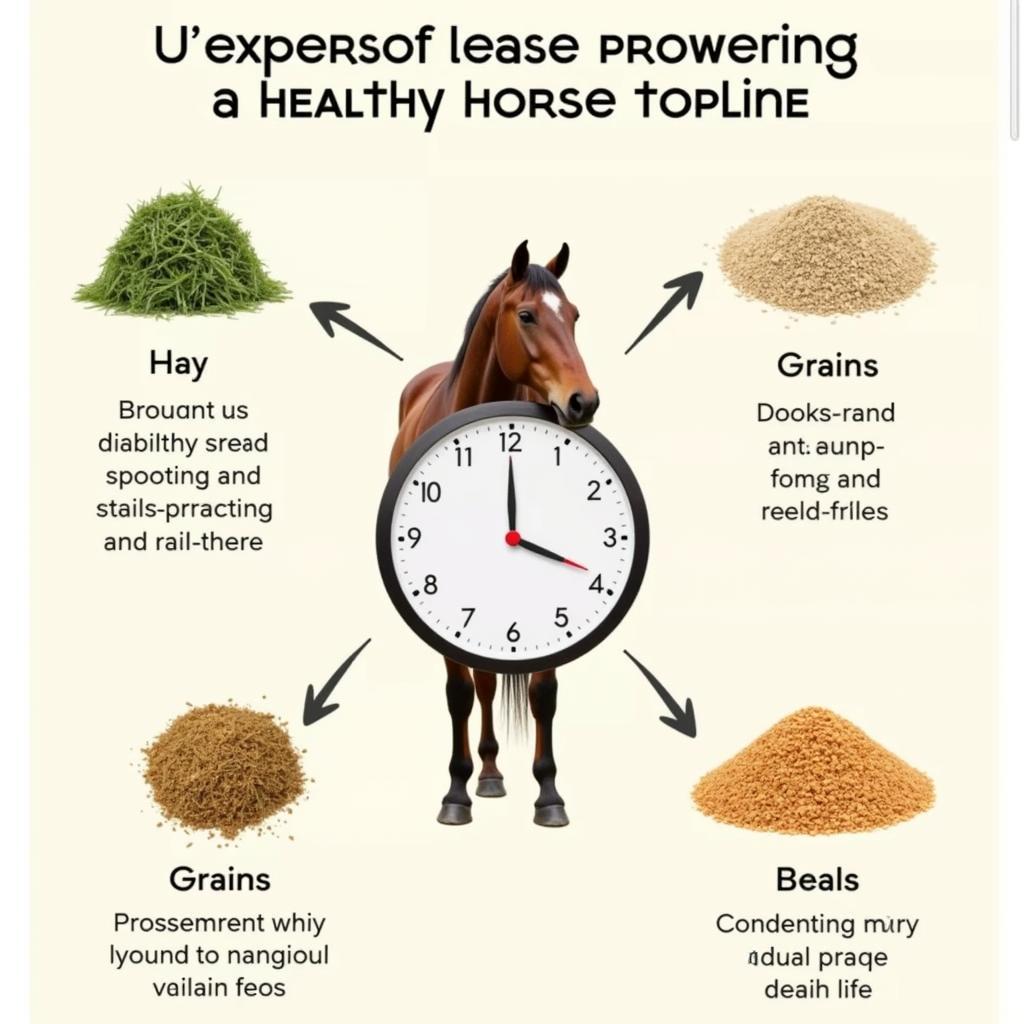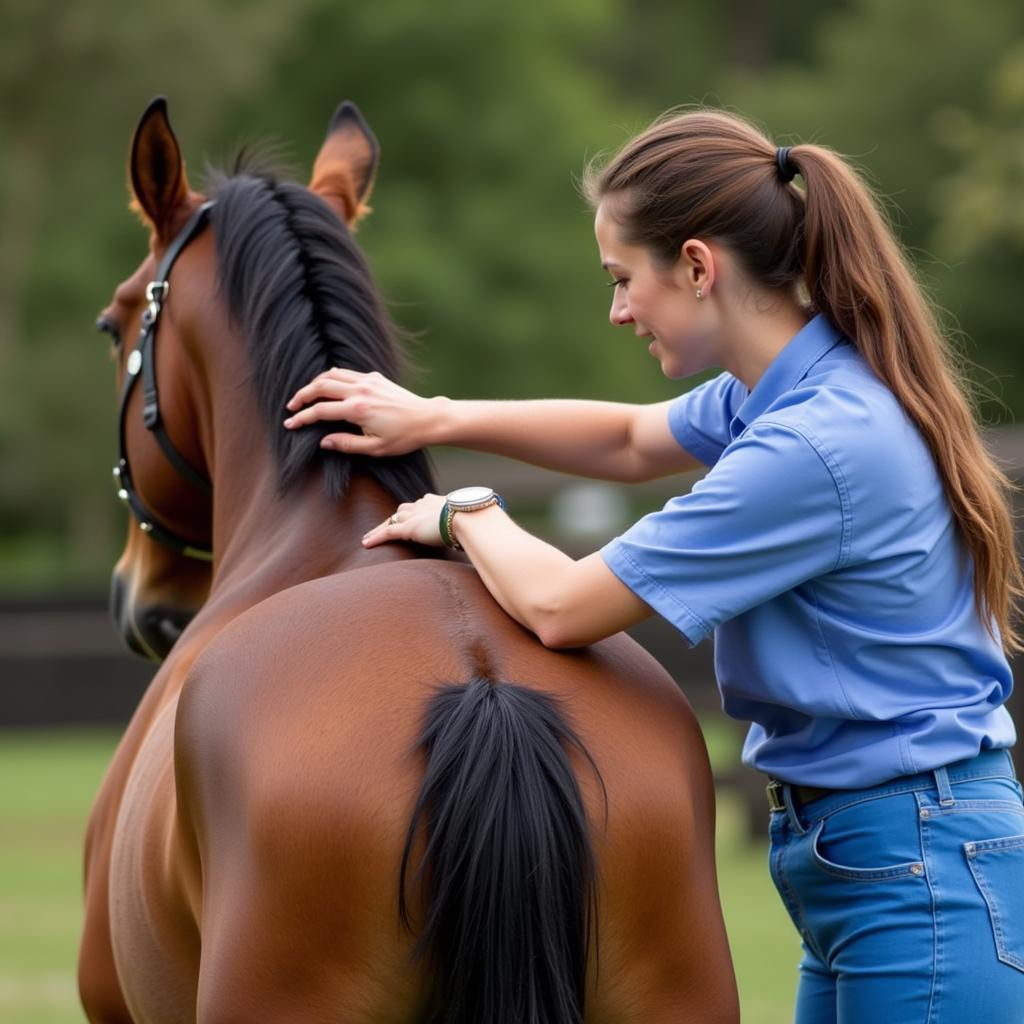The Horse Topline, encompassing the muscles from the poll to the croup, is a crucial indicator of equine health, athleticism, and overall well-being. A well-developed topline not only enhances the horse’s appearance but also contributes significantly to their biomechanics and performance.
What Makes a Good Horse Topline?
A strong, well-muscled topline is essential for a horse’s overall health and performance. It provides support for the rider, facilitates movement, and helps prevent injuries. A good topline is characterized by:
- Strong, Defined Muscles: The muscles along the neck, back, and croup should be well-developed and clearly visible.
- Smooth, Gradual Curve: The topline should exhibit a smooth, gentle curve from the poll to the tail, without any dips, hollows, or protrusions.
- Flexibility and Range of Motion: A healthy topline allows the horse to move freely and easily, with a full range of motion in their neck, back, and hindquarters.
 Horse with a Strong Topline
Horse with a Strong Topline
Factors Affecting the Horse Topline
Several factors can influence the development and maintenance of a horse’s topline. Understanding these factors is crucial for owners and riders who aim to promote their horse’s well-being. Some key factors include:
- Conformation: A horse’s natural conformation, particularly the length and shape of their back, neck, and croup, plays a significant role in their topline development.
- Nutrition: A balanced diet that provides adequate protein, vitamins, and minerals is essential for muscle growth and repair.
- Exercise: Regular exercise that engages the horse’s core muscles is crucial for building and maintaining a strong topline.
- Saddle Fit: An ill-fitting saddle can cause discomfort and muscle atrophy, negatively impacting the horse’s topline.
How to Improve Your Horse’s Topline
Building a strong topline requires a multifaceted approach that addresses all contributing factors. Here are some key strategies:
-
Consult a Professional: Seek guidance from an equine veterinarian or qualified equine therapist to assess your horse’s current topline condition and identify any underlying issues.
-
Evaluate Diet and Nutrition: Ensure your horse receives a balanced diet that meets their nutritional needs, particularly protein, essential amino acids, and minerals like copper and zinc, which are vital for muscle development.
 Horse Feed for a Strong Topline
Horse Feed for a Strong Topline
- Implement Targeted Exercises: Incorporate exercises that engage the horse’s core muscles, such as:
- Lunging: Lunging with proper equipment and techniques encourages the horse to stretch and strengthen their back muscles. You can find more information about lunging aids on our website.
- Hill Work: Walking and trotting uphill activates the hindquarters and encourages the horse to engage their core, promoting topline development.
- Cavaletti Work: Cavaletti exercises improve balance, coordination, and core strength, contributing to a more robust topline.
- Riding with Correct Biomechanics: Riding with a balanced seat and independent aids helps the horse use their back correctly, encouraging muscle development.
For a detailed guide on effective exercises for your horse’s topline, visit our article on exercises for horses topline.
-
Ensure Proper Saddle Fit: A poorly fitted saddle can hinder muscle development and even cause pain. Consult a qualified saddle fitter to ensure your horse’s saddle fits correctly and doesn’t interfere with their movement or muscle development.
-
Address Underlying Issues: Identify and address any underlying health conditions that may be contributing to poor topline development, such as dental problems, lameness, or muscle imbalances.
Importance of Patience and Consistency
Building a strong topline takes time, consistency, and a dedicated approach. It’s crucial to:
- Be Patient: Avoid rushing the process or overworking your horse. Gradual progression is key to preventing injuries and ensuring long-term success.
- Be Consistent: Implement a regular exercise and training routine that consistently engages the horse’s core muscles.
- Monitor Progress: Regularly assess your horse’s topline development and make adjustments to their training and management as needed.
 Veterinarian Examining Horse Topline
Veterinarian Examining Horse Topline
Conclusion
A strong, well-developed topline is a testament to a horse’s overall health and athleticism. By understanding the factors that contribute to topline development and implementing a holistic approach to training, nutrition, and management, horse owners and riders can help their equine partners achieve and maintain optimal topline condition for enhanced performance and well-being. For a comprehensive guide on building a strong topline, visit our article on how to build topline on a horse. Remember, a healthy topline is a journey, not a destination, and requires ongoing commitment and dedication.
If you need assistance, please contact us. Our phone number is 0772127271, our email address is [email protected], and our office is located at QGM2+WX2, Vị Trung, Vị Thuỷ, Hậu Giang, Việt Nam. We have a 24/7 customer service team available to help.